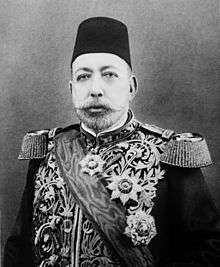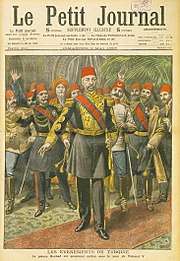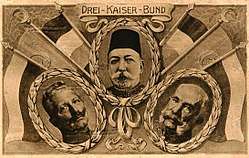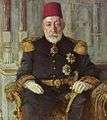Mehmed V
| Mehmed V | |||||
|---|---|---|---|---|---|
|
Caliph of Islam Amir al-Mu'minin Sultan of the Ottoman Empire Kayser-i Rûm Custodian of the Two Holy Mosques | |||||
 | |||||
| 27th Caliph of the Ottoman Caliphate 35th Ottoman Sultan (Emperor) | |||||
| Reign | 27 April 1909 – 3 July 1918 | ||||
| Sword girding | 10 May 1909 | ||||
| Predecessor | Abdul Hamid II | ||||
| Successor | Mehmed VI | ||||
| Grand Viziers | |||||
| Born |
2 November 1844 Topkapı Palace, Istanbul, Ottoman Empire | ||||
| Died |
3 July 1918 (aged 73) Yıldız Palace, Istanbul, Ottoman Empire | ||||
| Burial | Tomb of Sultan Mehmed V Reşad, Eyüp, Istanbul | ||||
| Consorts |
Kamures Kadın Dürrüaden Kadın Mihrengiz Kadın Nazperver Kadın Dilfirib Kadın | ||||
| Issue |
Şehzade Mehmed Ziyaeddin Şehzade Mahmud Necmeddin Şehzade Ömer Hilmi | ||||
| |||||
| Dynasty | Ottoman | ||||
| Father | Abdulmejid I | ||||
| Mother | Gülcemal Kadın | ||||
| Religion | Islam | ||||
| Tughra |
 | ||||
Mehmed V. Reşâd (Ottoman Turkish: محمد خامس Meḥmed-i ẖâmis, Turkish: Beşinci Mehmet Reşat or Reşat Mehmet) (2 November 1844 – 3 July 1918) was the 35th and penultimate Ottoman Sultan. He was the son of Sultan Abdulmejid I.[1] He was succeeded by his half-brother Mehmed VI. His nine-year reign was marked by the cession of the Empire's North African territories and the Dodecanese Islands, including Rhodes, in the Italo-Turkish War, the traumatic loss of almost all of the Empire's European territories west of Constantinople in the First Balkan War, and the entry of the Empire into World War I,[2] which would ultimately lead to the end of the Ottoman Empire.
Birth
He was born at the Topkapı Palace, Constantinople.[3] Like many other potential heirs to the throne, he was confined for 30 years in the Harems of the palace. For nine of those years he was in solitary confinement. During this time he studied poetry of the old Persian style and was an acclaimed poet. On his ninth birthday he was ceremoniously circumcised in the special Circumcision Room (Sünnet Odasi) of Topkapı Palace.
Reign
His reign began on 27 April 1909, but he was largely a figurehead with no real political power, as a consequence of the Young Turk Revolution in 1908 (which restored the Ottoman Constitution and Parliament) and especially the 1913 Ottoman coup d'état, which brought the dictatorial triumvirate of the Three Pashas to power.
Under his rule, the Ottoman Empire lost all its remaining territory in North Africa (Tripolitania, Cyrenaica and Fezzan) to Italy in the Italo-Turkish War and nearly all its European territories (except for a small strip of land west of Constantinople) in the First Balkan War. The sudden loss of these enormous swathes of land, which had been Ottoman territory for centuries and were ceded to its opponents within a span of only two years, was deeply shocking to the Ottoman Turks and resulted in massive popular backlash against the government, culminating in the 1913 Ottoman coup d'etat.
Mehmed V's most significant political act was to formally declare jihad against the Entente Powers (Allies of World War I) on 14 November 1914, following the Ottoman government's decision to join the First World War on the side of the Central Powers.[4] He was actually said to look with disfavor on the pro-German policy of Enver Pasha.[5]
This was the last genuine proclamation of jihad in history by a Caliph, as the Caliphate lasted until 1924. The proclamation had no noticeable effect on the war, despite the fact that many Muslims lived in Ottoman territories. Some Arabs eventually joined the British forces against the Ottomans with the Arab Revolt in 1916.
Mehmed V hosted Kaiser Wilhelm II, his World War I ally, in Constantinople on 15 October 1917. He was made Generalfeldmarschall of the Kingdom of Prussia on 27 January 1916, and of the German Empire on 1 February 1916.
 Le Petit Journal 1909, Mehmed V proclaimed Sultan.
Le Petit Journal 1909, Mehmed V proclaimed Sultan. Wilhelm II, Mehmed V, Franz Joseph: The three emperors of the Central Powers in the First World War.
Wilhelm II, Mehmed V, Franz Joseph: The three emperors of the Central Powers in the First World War. Sultan Mehmed V together with his entourage. Bitola, 1911. Photo from the Manaki Brothers (Damaged plate).
Sultan Mehmed V together with his entourage. Bitola, 1911. Photo from the Manaki Brothers (Damaged plate). Mehmed V and Enver Pasha hosting Wilhelm II in Constantinople during World War I.
Mehmed V and Enver Pasha hosting Wilhelm II in Constantinople during World War I. Sultan Mehmed V in Imperial Ottoman naval uniform.
Sultan Mehmed V in Imperial Ottoman naval uniform. Mehmed V in ceremonial uniform.
Mehmed V in ceremonial uniform. Portrait of Sultan Mehmed V.
Portrait of Sultan Mehmed V.
Death
Mehmed V died at Yıldız Palace on 3 July 1918 at the age of 73, only four months before the end of World War I.[6] Thus, he did not live to see the downfall of the Ottoman Empire. He spent most of his life at the Dolmabahçe Palace and Yıldız Palace in Istanbul. His grave is in the Eyüp district.
Decorations and awards
- Ottoman orders
Mehmed V was Grand Master of the following Ottoman Orders:

_-_ribbon_bar.png)


- Foreign orders and decorations
Family
- Consorts
Sultan Mehmed Reşad had five consorts:
- Kamures Kadın (m. 1872 Ganja, c. 1857 – Kuruçesme Palace, Istanbul, 30 April 1921, buried in Mehmed Reşad Mausoleum);
- Mihrengiz Kadın (m. 1876; Sochi, c. 1861 – Alexandria, Egypt, 12 December 1938, buried in Ömer Tosun Pasha Mausoleum);
- Dürrüaden Kadın (m. 1877; Sochi, c. 1861 – Validebağı Palace, Istanbul, 17 October 1909, buried in Gülüstü Hanım Mausoleum);
- Nazperver Kadın (m. 1888; Istanbul, c. 1873 – Kadınefendi Palace, Vaniköy, Istanbul, Turkey, 9 March 1929, buried in Yahya Efendi cemetery);
- Dilfirib Kadın (m. 1907; c. 1892 – Kadınefendi Palace, Vaniköy, Istanbul, Turkey, 1952).
- Sons
He had three sons:
- Şehzade Mehmed Ziyaeddin (Ortaköy Palace, Istanbul, 26 August 1873 – Alexandria, Egypt, 30 January 1938, buried in Ömer Tosun Pasha Mausoleum), married five times and had two sons and six daughters – with Kamures Kadın;
- Şehzade Mahmud Necmeddin (Veliahd Palace, Istanbul, 23 June 1878 – Kuruçeşme Palace, Istanbul, 27 June 1913, buried in Mehmed Reşad Mausoleum), unmarried and without issue – with Dürrüaden Kadın;
- Şehzade Ömer Hilmi (Veliahd Palace, Istanbul, 2 March 1888 – Alexandria, Egypt, 2 November 1935, buried in Ömer Tosun Pasha Mausoleum), married five times and had one son and one daughter – with Mihrengiz Kadın;
See also
References
- ↑ Abdulmecid, Coskun Cakir, Encyclopedia of the Ottoman Empire, ed. Gábor Ágoston, Bruce Alan Masters, (Infobase Publishing, 2009), 9.
- ↑ "Rusya Fransa ve İngiltere devletleriyle hal-i harb ilanı hakkında irade-i seniyye [Imperial Decree Concerning the Declaration of a State of War with the States of Russia, France, and the United Kingdom], Nov. 11, 1914 (29 Teşrin-i Evvel 1330), Takvim-i Vekayi, Nov. 12, 1914 (30 Teşrin-i Evvel 1330)" (PDF).
- ↑ The Encyclopædia Britannica, Vol.7, edited Hugh Chisholm, (1911), 3; "Constantinople, the capital of the Turkish Empire..".
- ↑ Lawrence Sondhaus, World War One: The Global Revolution, (Cambridge University Press, 2011), 91.
- ↑

- ↑ Mehmed V, Selcuk Aksin Somel, Encyclopedia of the Ottoman Empire, 371.
External links
![]()
- Newspaper clippings about Mehmed V in the 20th Century Press Archives of the German National Library of Economics (ZBW)
Mehmed V Born: 2 November 1844 Died: 3 July 1918 | ||
| Regnal titles | ||
|---|---|---|
| Preceded by Abdul Hamid II |
Sultan of the Ottoman Empire 27 Apr 1909 – 3 Jul 1918 |
Succeeded by Mehmed VI |
| Sunni Islam titles | ||
| Preceded by Abdul Hamid II |
Caliph of Islam 27 Apr 1909 – 3 Jul 1918 |
Succeeded by Mehmed VI |

